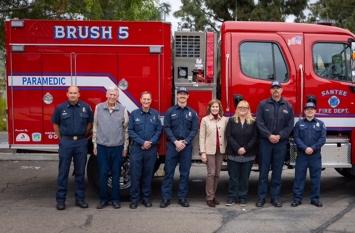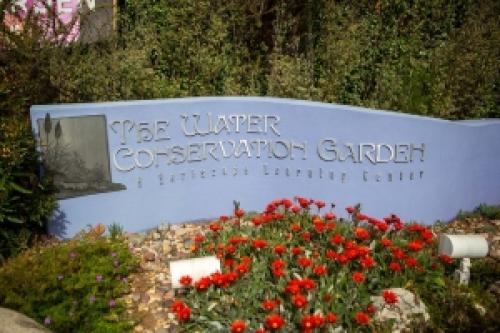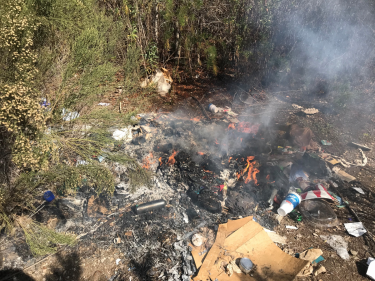
SANTEE GETS A NEW BRUSH FIRE ENGINE

By Mike Allen
Photo: Members of Santee Fire Dept, SD Regional Fire Foundation and the SD River Conservancy with new brush rig funded through the city along with grants from the two nonprofits.
August 11, 2025 (Santee)-- The city of Santee has another key tool in its goal of protecting the city from wildfires, a new brush fire engine.
City officials and the public will get together Aug. 20 for a “push-in” ceremony at Station No. 5 to celebrate the new engine, which was paid mostly from nonprofit grants.
- Read more about SANTEE GETS A NEW BRUSH FIRE ENGINE
- Log in or register to post comments
Wildfire & Emergency Resources Center
East County Magazine gratefully acknowledges our sponsors for our Wildfire & Emergency Resource Center: San Diego Regional Fire Safe Council, San Diego River Conservancy, and the Conrad Prebys Foundation for helping us keep our community members safe and informed.
- Read more about Wildfire & Emergency Resources Center
- Log in or register to post comments
COULD OUR REGION RUN OUT OF WATER IN A MAJOR WILDFIRE, AS HAPPENED WHEN L.A. FIRE HYDRANTS RAN DRY? HELIX WATER SHARES INFORMATION WITH LA MESA’S CITY COUNCIL

“It could happen, at any water system in the United States. The systems were not designed for what we what we witnessed in L.A.,” says Helix Water District general manager Brian Olney, though Helix has taken steps to reduce risk
By Karen Pearlman
March 20, 2025 (La Mesa) -- The city of La Mesa is being proactive on educating residents on emergency situations for water needs in case of out-of-control wildfires such as the January blazes that devastated Los Angeles County. Concerns about fires and lack of water to fight them led to elected officials in the city of La Mesa to have Helix Water District share insight and information about protection in a presentation at the March 11 City Council meeting.
DON'T RELY ON LUCK: SURVIVE AND RECOVER IN A DISASTER
By Yvette Urrea Moe, County of San Diego Communications Office
Video by José Eli Villanueva: prepare for a disaster with an emergency supplies kit, or “go bag.” When disaster strikes, often there are only a few minutes warning to evacuate. So, don’t wait until the warning comes, when you will likely be anxious and stressed, assemble your kit today and put it in a handy place to grab on your way out.
- Read more about DON'T RELY ON LUCK: SURVIVE AND RECOVER IN A DISASTER
- Log in or register to post comments
SANTEE COUNCIL MAKES FIRE PROTECTION ITS TOP PRIORITY
By Mike Allen
Photo by Scott Lagace: Santee firefighters saved the life of an unconscious woman during a July 2024 fire that engulfed her mobile home, also administering oxygen to save a cat.
- Read more about SANTEE COUNCIL MAKES FIRE PROTECTION ITS TOP PRIORITY
- Log in or register to post comments
SUPERVISORS WEIGH OPTIONS TO ADDRESS UNSAFE HOMELESS ENCAMPMENTS TO REDUCE FIRE DANGER

By Karen Pearlman
Photo via San Diego County Sheriff: Homeless encampment fire in Santee, February 2025
March 14, 2025 (San Diego’s East County) -- With an estimated one out of every five fires in San Diego County started in encampments where homeless individuals congregate, San Diego County Supervisor Joel Anderson has said enough is enough.
“Nobody has a right to burn my constituents’ homes down, whether they intend to or not,” Anderson said, two days after the Board of Supervisors voted unanimously to update the county’s Unsafe Camping Ordinance. It would apply to property that the county owns or leases and specified areas such as parks, open space and certain public works facilities.
At their meeting on Tuesday, March 11, the supervisors voted 4-0 to empower appropriate authorities “to ensure public safety and do more than just cite repeat offenders,” Anderson said. A final draft ordinance is expected to be presented by county staff to the board in about two months, when a final vote will take place.
STORM SERIES MOVING INTO AREA: FLOOD WATCH ISSUED

East County News Service
Last week’s storms brought 6-10 inches of snow to our mountains with up to 1.5 inches in urban portions of our county. Now, multiple new storms are moving into the area, with rain now falling across the region and multiple atmospheric rivers soon to drench our region, with the heaviest rains Thursday, the National Weather Service predicts. A flood watch has been issued now through Thursday afternoon for San Diego’s inland and coastal areas, including cities such as La Mesa, Santee, Poway, and Escondido as well as San Diego. Excessive runoff may result in flooding of rivers, streams, and other low-lying and flood-prone locations.
- Read more about STORM SERIES MOVING INTO AREA: FLOOD WATCH ISSUED
- Log in or register to post comments
ARREST MADE FOR SUSPECTED ARSON IN PALA AND LILAC FIRES
Source: Cal Fire
March 2, 2025 (San Diego) – Cal Fire law enforcement investigators have arrested Ruben Vasquez on multiple felony arson charges following an extensive investigation into two wildland fires that ignited on January 21. The fires, known as the Pala Fire and the Lilac Fire, started 25 minutes apart near Interstate 15 and State Route 76 in the Pala Mesa and Bonsall areas.
SANTEE FUNDS TEMPORARY FIRE STATION, SETS NEW PLAN FOR TOWN CENTER
By Mike Allen
Photo: Santee Fire Department responding in 2023
March 1, 2025 (Santee) -- The chaos and disruption happening daily at the federal government isn’t permeating to the local level in Santee, where the City Council took several significant actions this week, including funding the remaining balance on a $2 million temporary fire station, adopting a new specific plan for its Town Center area, and hearing that its finances are in sterling shape.
SENATOR PADILLA, COLLEAGUES PUSH TRUMP ADMINISTRATION TO EXEMPT SEASONAL FIREFIGHTERS FROM FEDERAL HIRING FREEZE
East County News Service
February 27, 2025 (Washington D.C.) -- U.S. Senator Alex Padilla (D-Calif.) joined 14 other Democratic Senators in urging senior Trump Administration officials to reverse the hiring and onboarding freeze of federal seasonal firefighters that they say threatens the safety of communities in California and across the nation. The Trump Administration’s January 20 hiring freeze of federal civilian employees inexplicably did not exempt federal seasonal firefighters, despite exempting other critical public safety personnel.
